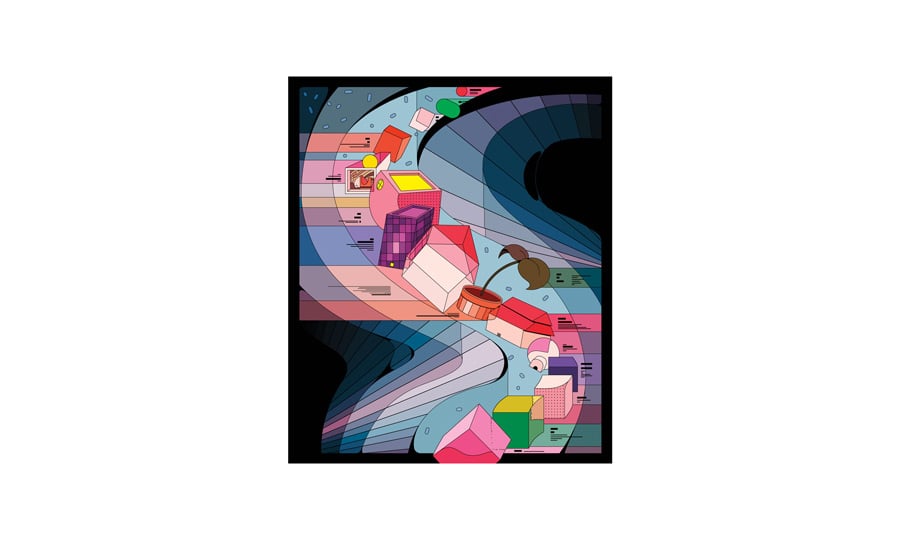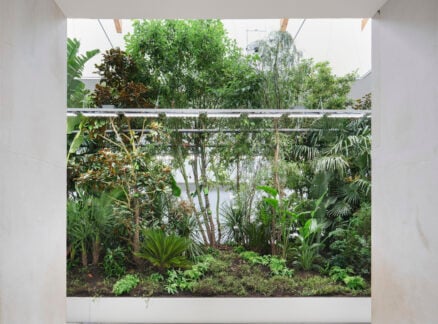
March 1, 2021
Gurus at Five Firms Predict the Good Ways Disruptive Technology Will Change Design
Pros from Gensler, SOM, SmithGroup, Arup, and IA Interior Architects share their views on what practice looks like with the new tools.

Technology is changing the world as we know—and design—it. But have architects and designers unlocked the full potential of cutting-edge digital tools? Practitioners with a visionary approach from Gensler, IA Interior Architects, Arup, SmithGroup, and SOM examine some of the most influential and disruptive technologies today—like blockchain, VR/AR/MR, spatial computing, machine learning, and cloud computing—and envisage their impact on the practice of architecture and interior design tomorrow. The changes they describe, while forecasts, will likely come to fruition, driving the way we plan, work, and create. Consider this a glimpse of the not-so-distant future.

Kirsten Ritchie on CRACKING SUSTAINABILITY WITH BLOCKCHAIN
Blockchain is just a new version of a database. Except instead of big tables and server farms, it takes every new bit of information, creates a block, and sticks it on the end of the chain. In essence, every transaction is documented and time-stamped. And it’s non-editable, so the history is always there.
From a design perspective, I think it has the ability to massively simplify product attribute verification. Beyond color, design, and performance, we are interested in a growing number of environmental attributes: Is the product low emitting? What is the carbon footprint? Does the product come with an ingredient disclosure? Is it sustainably sourced? Consider the number of products that go into a project. Take those tens of thousands of SKUs and multiply them by an average of 30 attributes for each product. In the end, you’ve got 300,000 items that you’re trying to track for overall performance and accountability. We’re using great design talent to search databases and gather this information, but blockchain could enable us to do all that tracking very quickly.
I also think that this kind of data tracking could drive more manufacturers to create products with attributes more aligned with what our clients desire. If it’s quick and easy to find out whether or not a product meets certain sustainable standards, it’s much easier for designers and contractors to justify their requests.
There’s a plethora of data and we need a better way to streamline, organize, access, and translate it into real knowledge. Blockchain could save designers time and effort, help drive producers to meet our aspirational goals, and, in turn, cause market transformation.

Rob DeMillo on CREATING A FUTURE OF POSSIBILITY WITH CLOUD COMPUTING
Architecture, engineering, and construction firms spend hundreds of millions of dollars annually on machines and technology that will be trailing edge within a few years. Everything from on-site inventory computers to $10,000 workstations are generally investments that depreciate upon purchase.
The best way forward is to put our money to better use in cloud computing. As part of that, firms should increase their wired and wireless network infrastructure in offices and at worksites, as well as upgrade to faster home internet and mobile 5G services for all staff.
By assisting staff in transitioning away from localized computing, firms can reduce costs over time and also begin to think of their offerings as a series of platform services. While cloud-based platforms empower staff to more freely collaborate with distant coworkers and clients, it more importantly creates the space to plan grander visions. This ultimately enables firms to establish a technological identity outside of their specific design and engineering aesthetic.
The industry can take lessons from other verticals: Common databases, compute services, machine learning algorithms, and extended site monitoring allow firms to not only design and build more efficiently and collaboratively but also continue to be present throughout a structure’s life. Feeding information on features like HVAC systems, sustainability, and structural integrity into cloud computing centers enables designers to enhance a building over time. This would tip the typical firm’s business model to include monitoring and maintenance long after a structure is built.

Leland Curtis on USING MACHINE LEARNING TO DESIGN SMARTER
Machine learning will enable a more integrated, informed design process by disrupting how and when architects engage with data. If we begin by viewing machine learning as a collection of algorithmic tools that refine data into information—just as a saw helps to shape wood into furniture—the opportunities these tools present become more focused.
I imagine machine learning tools will help design professionals understand the impact of decisions as they are made—not days or weeks later. Methods such as surrogate modeling, which uses regressor algorithms to replace slow calculation engines with an instantaneous predictive “surrogate,” will support real-time, data-rich design interfaces that allow teams to react at the speed of a designer’s curiosity.
I expect future engineers will operate like data analysts. They will spend most of their time modeling, analyzing, and explaining data rather than manually operating analysis software. For example, once a design challenge is parametrically modeled and translated into structured data—an approach we call design space exploration—simple algorithms like multiple linear regression can measure which parameters have the greatest impact on performance. Clustering algorithms, classifiers, and dimensionality reduction techniques can then be used to tease out obscure relationships that can provide actionable direction to teams.
These algorithms represent a fraction of the machine learning tools that design professionals can and should learn to use. But machine learning algorithms are not magic. They are tools of the information age that we can leverage to better inform the design process moving forward.

Gideon D’Arcangelo on BUILDING SENTIENT ENVIRONMENTS WITH SPATIAL COMPUTING
We should use spatial computing to make our built environments respond to occupants’ needs in the most effective and agile ways. This will continue the trajectory we are already on: We have created spaces with networks of sensors that constantly track internal and external conditions. We have given buildings a voice so they can speak to occupants through data that convey energy use and indoor air quality. We have equipped our buildings with motors so they can move—algorithmically making physical adjustments when certain environmental parameters are met, such as automatically opening windows and shutting down air-conditioning when the weather is right.
The next step in this journey is to make buildings adapt and respond to the people within, observing their behavioral patterns and learning how to anticipate their needs. Imagine a conference room that configures its spatial layout for a collaborative workshop, then shape-shifts to support a presentation, and then reorganizes to host a board meeting. Imagine if, for that collaborative workshop, the room knows who the players are, knows who is remote and who is physically present, remembers how the room was set up the last time they met, pulls relevant files, and sets up an optimum environment for them to continue working where they left off.
As designers, we must first learn how to create well-formed, purpose-built digital twins, or virtual replicas of these physical devices, to advance this vision of adaptable environments that optimize inhabitants’ experience. This high level of digital and physical integration is key, as it provides the brainpower to make buildings behave more like living organisms.

Kat Schneider on USING VR/AR/MR TO CRAFT THE NEXT GENERATION OF DESIGNED ENVIRONMENTS
The industry today still thinks about virtual, augmented, and mixed reality technology as predominantly a vehicle for representing design as part of the visualization tool kit. But the impact of immersive technology on architecture and interior design is far more expansive. VR/AR/MR carry the potential not just to represent a space but rather to be a designed form of space itself.
At a macro level our relationship with tech is drastically shifting, as we evolve from spectators watching digital content on a screen to participants immersed in technology using highly personal, wearable devices. This presents a call to action for architects and designers to carefully consider the ways in which the flexibility of virtual space can be used as a true extension of physical space to better serve the ever-evolving needs of end users.
Neurologically and psychologically VR/AR/MR environments form a new generation of lived experiences in space. Within our IAXR Extended Reality practice, we are currently exploring how designers think about this next evolution of designed environments. What these environments look like, how they function, and how they feel need to be crafted and designed with the same rigor we consider the physically built environment. Architects and interior designers have a prominent place at the table in the development of these tools and technologies. It is our responsibility to apply our expertise in creating a sense of place in the physical world to also ensure success, comfort, and usability in the virtual realm.
You may also enjoy “Studio O+A’s Toolkit Says Returning to the Office Can Be Joyful”
Would you like to comment on this article? Send your thoughts to: [email protected]
Register here for Metropolis’s Think Tank Thursdays and hear what leading firms across North America are thinking and working on today.
Recent Viewpoints
Viewpoints
Sustainability News Updates for Q2 2025





